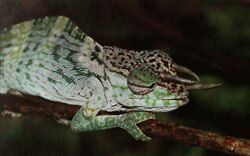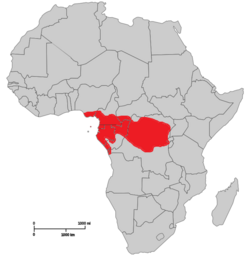Biology:Owen's chameleon
| Owen's chameleon | |
|---|---|

| |
| male | |
| Scientific classification | |
| Domain: | Eukaryota |
| Kingdom: | Animalia |
| Phylum: | Chordata |
| Class: | Reptilia |
| Order: | Squamata |
| Suborder: | Iguania |
| Family: | Chamaeleonidae |
| Genus: | Trioceros |
| Species: | T. oweni
|
| Binomial name | |
| Trioceros oweni (Gray, 1831)
| |

| |
| A map illustrating the range of Owen's chameleon | |
| Synonyms[1] | |
| |
Owen's chameleon (Trioceros oweni), also commonly known as Owen's three-horned chameleon, is a species of lizard in the family Chamaeleonidae. The species is native to forests in central Africa. Named after British naval officer and explorer William Fitzwilliam Owen,[2] it was first described in 1831 by the naturalist John Edward Gray, and is the type species of the genus Trioceros.[1]
Distribution and habitat
Owen's chameleon can be found in much of tropical central Africa, from the Niger Delta in Nigeria in the north, to Angola in the south, and Burundi in the east.[3] It inhabits dense evergreen and semi-deciduous forests at altitudes lower than 800 m (2,600 ft) above sea level, usually living in large trees.[4] The type locality for the species is the island of Bioko in Equatorial Guinea.[1] File:Chamaeleo tricornis - 1700-1880 - Print - Iconographia Zoologica - Special Collections University of Amsterdam - UBA01 IZ12300055.tif
Description and behavior
Like many other chameleons, Owen's chameleon has a prehensile tail and a single claw on each toe. Males have three smooth horns,[5] while females lack horns but have loose skin on their hind legs that gives the impression of wearing baggy trousers. On average, adult Owen's chameleons range from 25 to 28 cm (9.8 to 11.0 in) in total length (including tail),[4] while a typical weight is around 75 g (2.6 oz).[6] The species is generally arboreal and will leap from branch to branch or to the ground in order to avoid predators; it tends to feed on insects.[3]
Conservation and threats
Because of its wide range, abundance, and population stability, Owen's chameleon is ranked Least Concern by the International Union for Conservation of Nature. However, there are concerns that logging and agricultural expansion may contribute to deforestation and potentially threaten the status of the species. In addition, it is occasionally exploited via the pet trade or traded locally to be used in traditional medicine; some tribes in the Democratic Republic of the Congo believe that scorched body of an Owen's chameleon can be used as a protective talisman, while around Yaounde in Cameroon the species is utilized as a treatment for maladies believed to be magical.[3]
References
- ↑ 1.0 1.1 1.2 Species Trioceros oweni at The Reptile Database
- ↑ Beolens, Bo; Watkins, Michael; Grayson, Michael (2011). The Eponym Dictionary of Reptiles. Baltimore: Johns Hopkins University Press. xiii + 296 pp. ISBN:978-1-4214-0135-5. (Chamaeleo oweni, p. 198).
- ↑ 3.0 3.1 3.2 Cite error: Invalid
<ref>tag; no text was provided for refs namediucn status 12 November 2021 - ↑ 4.0 4.1 Chirio, Laurent; Lebreton, Matthew (2007). Atlas des reptiles du Cameroun. Patrimoines naturels. 67. Paris: Muséum national d'Histoire naturelle. ISBN 9782856536032. OCLC 470695165.
- ↑ Gonwouo, Legrand N.; LeBreton, Matthew; Wild, Chris; Chirio, Laurent; Ngassam, Pierre; Tchamba, Martin N. (20 November 2006). "Geographic and ecological distribution of the endemic montane chameleons along the Cameroon mountain range". Salamandra 42: 213–230. ISSN 0036-3375. http://www.mosaic.cm/downloads/Gonwouo_chameleons_cameroon.pdf.
- ↑ "Owen's Chameleon - Chamaeleo oweni - Overview - Encyclopedia of Life" (in en). http://eol.org/pages/454512/overview.
Further reading
- Boulenger GA (1887). Catalogue of the Lizards in the British Museum (Natural History). Second Edition. Volume III. ... Chamæleontidæ. London: Trustees of the British Museum (Natural History). (Taylor and Francis, printers). xii + 575 pp. + Plates I-XL. (Chamæleon owenii, p. 470).
- Gray JE (1831). "Description of a new Chamaeleon discovered by Capt. Owen in Africa". Zoological Miscellany 1: 7. (Chameleo oweni, new species).
- Nečas P (1999). Chameleons: Nature's hidden jewels. Frankfurt am Main, Germany: Edition Chimaira. 348 pp. ISBN:3-930612-04-6 (Europe), ISBN:1-57524-137-4 (USA, Canada).
- Tilbury CR, Tolley KA (2009). "A re-appraisal of the systematics of the African genus Chamaeleo (Reptilia: Chamaeleonidae)". Zootaxa 2079: 57-68. (Trioceros oweni, new combination).
Wikidata ☰ Q3539439 entry
 |


